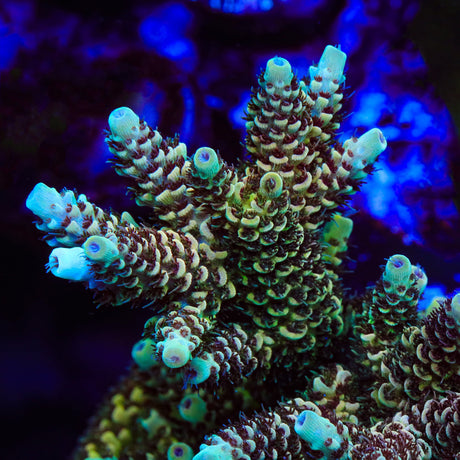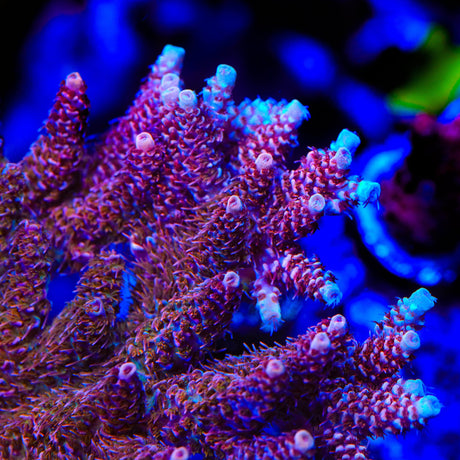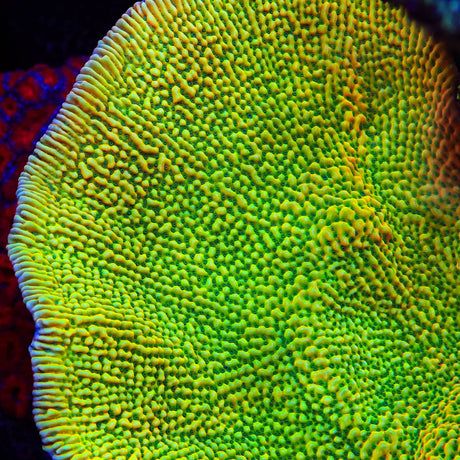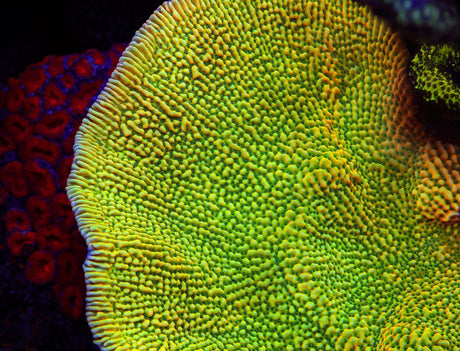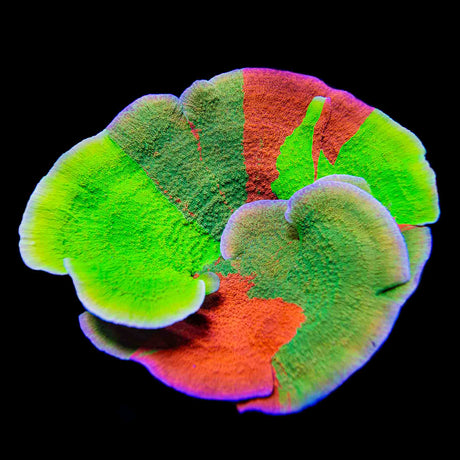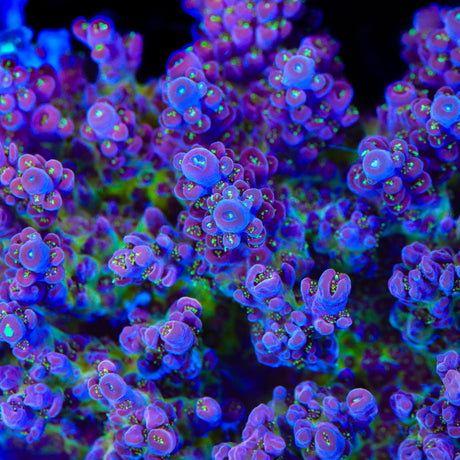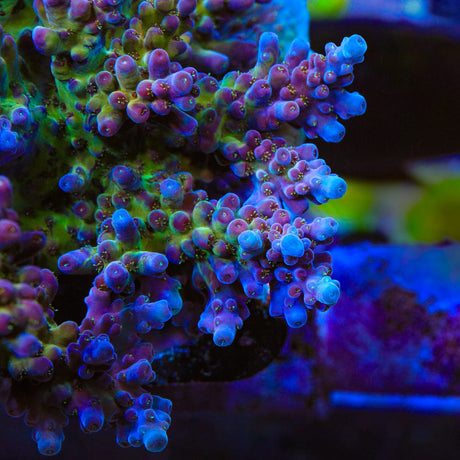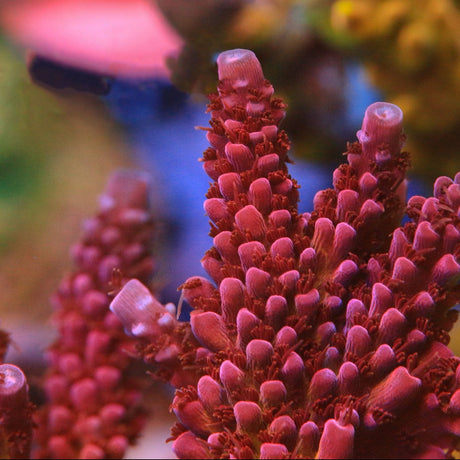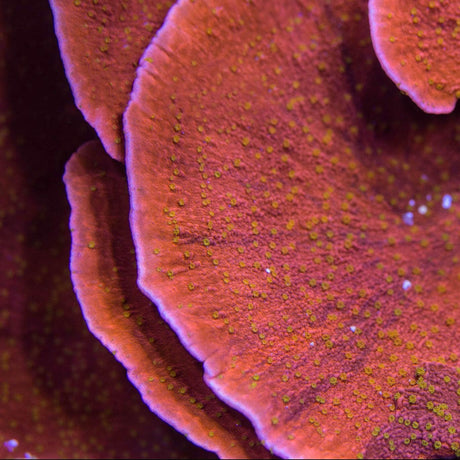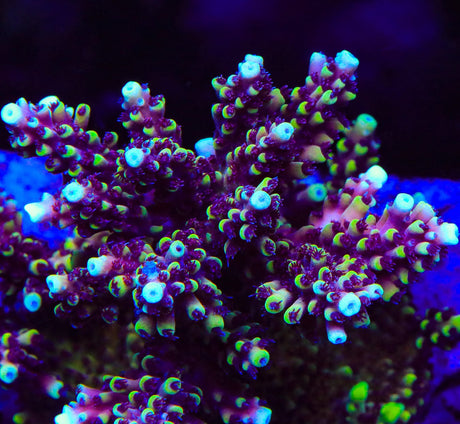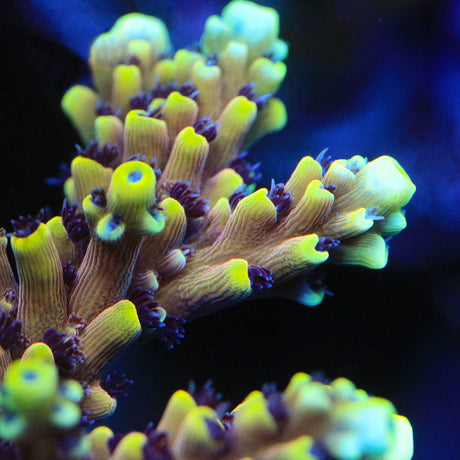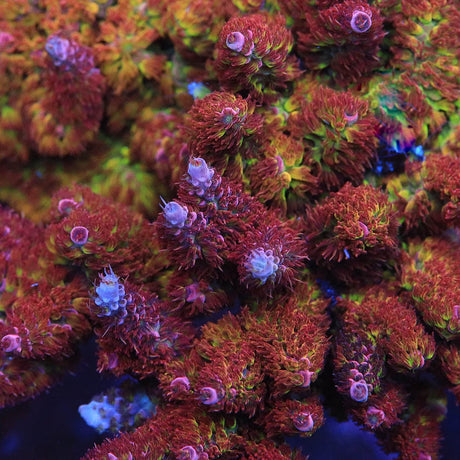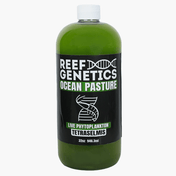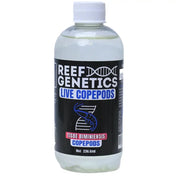Dive Deeper Into SPS Corals: Lighting, Flow, and Care
SPS Corals offer some of the most striking structure, color, and growth potential in the reefing world, but they also demand consistency. These Small Polyp Stony corals thrive in clean, stable systems with strong lighting, brisk water movement, and minimal nutrient fluctuations. If you’re looking to add shape and complexity to your reef, this collection is a great place to start.
At Top Shelf Aquatics, we focus on aquacultured SPS corals, grown in-house under tightly controlled conditions and fully healed before shipping. You’ll find a wide variety of SPS coral frags online, including branching Acropora, plating Montipora, and rarer species that bring bold texture and color to your tank.
Placement matters. We recommend starting your new SPS coral frags low in the tank and gradually moving them into higher PAR zones over time. While most of our frags are used to high-intensity light and variable flow, slow acclimation helps avoid shock. Many SPS also respond well to light feedings of fine particulate foods, especially in low-nutrient systems, just remember, less is more.
What Makes SPS Corals Unique?
SPS corals are some of the most rewarding and demanding corals in the reefing hobby. Their success depends on consistent water chemistry, strong lighting, and turbulent, high-velocity flow. Even small shifts in alkalinity or salinity can trigger stress responses like polyp retraction or tissue loss.
That’s why we focus on aquacultured SPS frags that are fully adapted to reef tank conditions. Grown in stable, high-energy systems and conditioned to thrive under intense light and movement, they offer a more reliable path to success than wild-collected specimens.
What to Know Before Buying SPS Corals
Keeping SPS corals successfully comes down to one core principle: stability. Unlike more forgiving coral types, SPS respond quickly to changes in water chemistry, lighting, and flow. But with a mature system and a dialed-in routine, they can reward you with impressive growth, rich coloration, and long-term health.
Below, we’ll walk through the key care requirements lighting, flow, water chemistry, and nutrients to help you decide if your tank is ready.
Lighting Requirements
SPS corals need high-intensity lighting to fuel photosynthesis and skeletal development. Most species thrive in a PAR range of 150–400+, with branching Acropora preferring the higher end and Montipora or plating varieties doing well in lower-to-mid zones.
Spectrum plays a key role too—more white light encourages faster growth, while deeper blues help bring out vivid coloration. At Top Shelf Aquatics, we grow all of our SPS under a tested combination of Ecotech Radions and metal halides, dialed in to achieve both color and structure.
Water Flow
Strong, chaotic flow is essential for SPS coral health. It helps clear waste from the coral’s surface, improves gas exchange, and encourages full polyp extension. Without enough movement, tissue can recede and algae may begin to grow on the skeleton.
To maintain the right conditions, aim for high, variable flow across your aquascape. In our systems, we use a mix of Ecotech MP-series pumps, Octo Pulse units, and Sicce XStream wave makers to keep water moving dynamically across every surface.
Water Chemistry
SPS demand stable, consistent water parameters. Even minor fluctuations—especially in alkalinity or salinity—can lead to stress, polyp retraction, or tissue loss.
Here are the ideal target ranges for a healthy SPS system:
- Alkalinity: 8.0–9.5 dKH
- Calcium: 420–450 ppm
- Magnesium: 1300–1400 ppm
- Nitrate: 5–15 ppm
- Phosphate: 0.01–0.03 ppm
- Salinity: 1.025–1.026
- pH: 8.1–8.4 (higher pH supports faster skeletal growth)
- Temperature: 76–78°F
To maintain these levels, many reefers use automated dosing, calcium reactors, or kalkwasser. The key is consistency—large or sudden shifts can trigger RTN (rapid tissue necrosis) or STN (slow tissue necrosis), especially in more sensitive Acropora species.
Feeding and Nutrients
SPS corals rely primarily on light for energy, but supplemental feeding can make a big difference—especially in low-nutrient systems. In ULNS (Ultra Low Nutrient Systems) setups, corals may appear pale or washed out if they’re not receiving enough nutrition beyond photosynthesis.
Targeted feeding with small-particle foods like phytoplankton, amino acids, and coral blends can help improve coloration, polyp extension, and overall tissue health. At Top Shelf Aquatics, we feed our SPS a mix of Tisochrysis, Rhodomonas, and Tetraselmis, along with Reef Roids and Benepets—all fine enough for efficient polyp uptake.
Tank Maturity & Placement
SPS corals aren’t suited for newly cycled systems. They need a mature, stable environment—typically at least 6 months old—with no major swings in parameters. Trying to add them too early often leads to stress, poor coloration, or tissue loss.
Placement should reflect both the lighting and flow preferences of the species. Encrusting Montipora generally do well lower in the tank with moderate PAR and flow. Branching Acropora thrive near the top under intense light and heavy movement. Mid-range options like Stylophora or Birdsnest corals are ideal for areas with moderate light and brisk, randomized flow.
